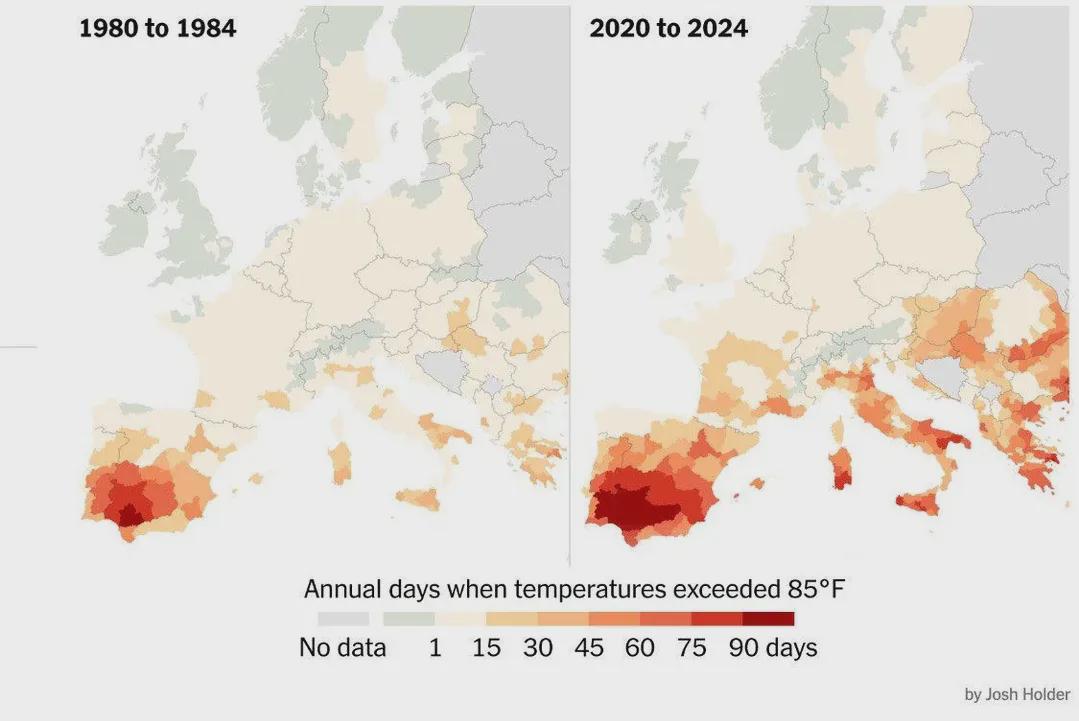Days Over 30ºC in Europe Map


Alex Cartwright
Senior Cartographer & GIS Specialist
Alex Cartwright is a renowned cartographer and geographic information systems specialist with over 15 years of experience in spatial analysis and data...
Geographic Analysis
What This Map Shows
The visualization titled "Number of Days per Year When Temperatures Exceeded 30ºC (85°F) in Europe" provides a comprehensive look at how often temperatures soar above 30 degrees Celsius across various regions in Europe. This map highlights the frequency of hot days, which can significantly impact local climates, ecosystems, and human activities. By visually representing this data, we can better understand the varying climates experienced by different areas of the continent.
Deep Dive into Temperature Trends in Europe
Temperature is a critical component of climate, influencing not only the weather but also the overall environment and lifestyle of a region. Europe, with its diverse geographical features, experiences a wide range of temperatures throughout the year. The average climate varies from the Mediterranean warmth of southern countries to the cooler, temperate climates found in northern regions.
Interestingly, the past few decades have shown a marked increase in the number of days exceeding 30ºC, particularly in southern Europe. Countries like Spain, Italy, and Greece frequently experience heatwaves that push temperatures well above this threshold during the summer months. For instance, some regions of southern Spain can exceed 40ºC for several days at a time, particularly in July and August. This trend is not just a summer anomaly; it has implications for agriculture, water resources, and public health.
The map reveals that countries such as Portugal and parts of France also see a significant number of hot days, indicating a broader trend of warming across Europe. In contrast, northern countries like Norway and Sweden typically report far fewer days above 30ºC, showcasing the climatic divide that exists within the continent. The Scandinavian region, known for its cool summer temperatures, is an interesting comparison to southern Europe where extreme heat is becoming more common.
Climate change is a crucial factor driving these shifts in temperature. As global temperatures rise, we can expect to see more frequent and intense heatwaves across Europe. This reality poses serious challenges, not only for the environment but also for human health, as prolonged exposure to high temperatures can lead to heat-related illnesses and increased mortality.
Furthermore, urban areas tend to experience what is known as the urban heat island effect, where cities become significantly warmer than their rural surroundings due to human activities, infrastructure, and land use. This phenomenon is particularly pronounced in cities like Madrid, Rome, and Athens, where the concentration of buildings and vehicles can elevate temperatures even higher.
Regional Analysis
When we break down the map by region, some distinct patterns emerge. Southern Europe, including countries like Spain, Italy, and Greece, stands out with the highest counts of days above 30ºC. For example, southern Spain, specifically the region of Andalusia, can see upwards of 80 days a year exceeding this temperature. In contrast, central European countries like Germany and Austria report significantly fewer hot days, averaging around 10 to 20 days annually.
Interestingly, Eastern Europe presents a mixed picture. While countries like Hungary and Romania experience a fair amount of hot days, regions such as Poland and the Czech Republic tend to be cooler, with fewer than 15 days exceeding 30ºC. This results in a fascinating climate mosaic, influenced by geography, elevation, and proximity to bodies of water.
Northern Europe, including the Scandinavian countries, remains largely shielded from extreme heat, with many areas experiencing only a handful of days above 30ºC per year. However, it is essential to note that even in these regions, climate patterns are changing. The warming climate could lead to a shift in these dynamics, making it crucial for policy-makers to monitor and adapt to these changes.
Significance and Impact
Understanding the number of hot days in Europe is more than an academic exercise; it has real-world implications for agriculture, infrastructure, public health, and energy consumption. As temperatures rise, crops may suffer from heat stress, leading to lower yields and food shortages. Additionally, urban areas need to prepare for increased energy demands due to air conditioning usage, which can strain power grids during peak times.
Moreover, as the number of hot days increases, public health officials must be vigilant about heat-related health issues. Vulnerable populations, including the elderly and those with pre-existing health conditions, are at greater risk during heatwaves. This highlights the importance of community preparedness programs and public health campaigns to mitigate the impact of extreme heat.
In conclusion, the map depicting the number of days when temperatures exceed 30ºC in Europe serves as a vital tool for understanding the changing climate landscape of the continent. As we continue to witness the effects of climate change, it will be crucial to monitor these trends and their implications for both the environment and society. By being aware of these patterns, we can better prepare for the future and work towards sustainability in a warming world.
Visualization Details
- Published
- August 14, 2025
- Views
- 214
Comments
Loading comments...